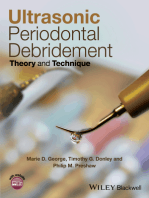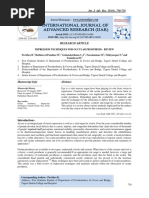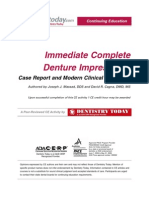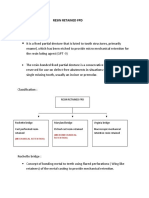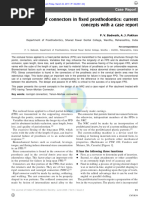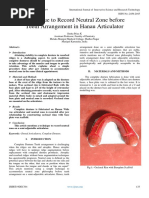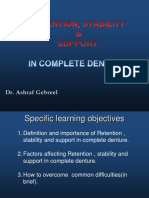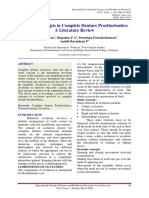Double-Casting Method For Fixed Prosthodontics With Functionally Generated Path
Double-Casting Method For Fixed Prosthodontics With Functionally Generated Path
Uploaded by
Chirag PatelCopyright:
Available Formats
Double-Casting Method For Fixed Prosthodontics With Functionally Generated Path
Double-Casting Method For Fixed Prosthodontics With Functionally Generated Path
Uploaded by
Chirag PatelOriginal Title
Copyright
Available Formats
Share this document
Did you find this document useful?
Is this content inappropriate?
Copyright:
Available Formats
Double-Casting Method For Fixed Prosthodontics With Functionally Generated Path
Double-Casting Method For Fixed Prosthodontics With Functionally Generated Path
Uploaded by
Chirag PatelCopyright:
Available Formats
THE JOURNAL OF PROSTHETIC DENTISTRY MINAGI ET AL
Double-casting method for fixed prosthodontics with functionally generated
path
Shogo Minagi, DDS, PhD,a Toshiyuki Tanaka, DDS,b Takashi Sato, DDS,
PhD,c and Tadashi Matsunaga, DDS, PhDd
Department of Removable Prosthodontics, Okayama University Dental
School, Okayama, Japan
Statement of problem. The construction of precise fixed prostheses that are harmonious within the
stomatognathic function has been regarded as a critical requirement for successful oral rehabilitation.
However, techniques for construction have been unsuccessful in producing a prosthesis that can be
inserted without intraoral occlusal adjustment.
Purpose. In this study, a new method of constructing a precise prosthesis that requires limited occlusal
adjustment at the final seating is described.
Material and methods. The precision of this method was compared with a conventional method.
Fourteen artificial crowns were fabricated on an experimental abutment by using both double-casting and
conventional methods. The distances between the cusp tips and occlusal surfaces of the abutments, which
were measured on wax/resin patterns and resultant crowns, were recorded to estimate clinical error for
each method.
Results. Error for the double-casting method was markedly less than the conventional method. This
study demonstrated that a new double-casting method was precise and sufficiently reliable for clinical
application. (J Prosthet Dent 1998;79:120-24.)
CLINICAL IMPLICATIONS
This study presented an innovative technique for construction of fixed prostheses that
require precise occlusion. This investigation also presented experimental data that sup-
ported the double-cast technique as a viable approach in accurately reproducing a
difficult occlusal topography for a cast restoration. This method could be extremely
useful for clinical conditions that require detailed occlusal adjustments of provisional
restorations to ensure harmonious occlusion of the definitive restoration.
T he construction of precise fixed prostheses
should be in harmony with the stomatognathic system
in the base-crown. The base-crown is trial seated to the
abutment and the proximal contact adjusted to the ad-
to ensure the quality of oral rehabilitation. Several spe- jacent tooth.
cial techniques, such as the functionally generated path After adjustment of the base-crown, the occlusion is
(FGP) technique,1,2 and CAD/CAM system3,4 have been functionally developed intraorally by molding autocuring
developed to meet these requirements.5-7 However, there acrylic resin (Uni-fast II, GC Corp., Tokyo, Japan) dur-
are no successful techniques for construction of cast pros- ing mandibular excursions (Fig. 1, B). The function of
theses that minimize intraoral occlusal adjustment. the artificial crown can be verified by temporary cemen-
tation to the abutment for several days. After removal of
DOUBLE-CASTING METHOD the base-crown with the resin pattern from the mouth,
The first step in a double-casting method is a base- it is sprued, invested, and cast. This second casting pro-
crown made according to the conventional indirect cedure is usually accomplished within a day and the fi-
method on a stone die (Fig. 1, A). A base-crown is a nal crown inserted the same day.
cast crown that has mechanical retention (retentive The purpose of this study is to report a new method
beads) on the occlusal surface rather than conventional of constructing a precise cast prosthesis that requires
occlusal anatomy. Proximal contact points are included only limited occlusal adjustment at the final seating. The
precision of this method is compared with a conven-
a
tional method. A clinical situation is shown in Figure 2.
Associate Professor.
b
Research Student.
Figure 2, A demonstrates the base-crown fitted to the
c
Professor and Chairman. abutment. The resin occlusal structure is illustrated in
d
Research Associate. Figure 2, B, while the final crown cemented to the abut-
120 THE JOURNAL OF PROSTHETIC DENTISTRY VOLUME 79 NUMBER 2
MINAGI ET AL THE JOURNAL OF PROSTHETIC DENTISTRY
Fig. 1. Diagram of artificial crown fabricated by double-cast-
ing method. A, Base-crown fitted to abutment intraorally. Proxi-
mal contact with adjacent tooth was also adjusted. B, On
occlusal surface of base-crown, occlusal structure is function-
ally developed intraorally by molding autocuring acrylic resin
during functional movements of mandible.
ment is shown in Figure 2, C. Occlusal adjustment was
unnecessary for this restoration.
MATERIAL AND METHODS
Master abutment
The master abutment was made of silver-gold-palla-
dium (Ag-Au-Pd) alloy (Fig. 3) and was 4 mm in height
with a taper angle to the axial wall of 6 degrees. Experi-
mental artificial crowns were fabricated from this mas-
ter abutment with the use of the conventional and
double-casting methods. The accuracy of these two Fig. 2. Artificial crown fabricated by double-casting method.
A, Base-crown fitted to abutment. B, Base-crown with resin
methods was evaluated by dimensional reproducibility
occlusal structure. C, Final crown cemented to abutment.
of the occlusal anatomy.
Measurement of dimensional reproducibility
working dies with 28 gauge sheet wax to achieve an even
Double-casting method. Seven impressions were made thickness for the occlusal surface of each specimen. Re-
of the master abutment with silicone rubber impression tentive beads (Retention beads S, GC Corp.) were se-
material (Exafine, GC Corp.) in individual trays. The cured to the occlusal surfaces of the wax patterns. The
impressions were cast in dental stone (Die Stone, Bayer, wax patterns were then cast with Ag-Au-Pd alloy, and
South Bend, Ind.), and seven working dies were made. the casting of the base-crowns fitted to the master abut-
The wax patterns of the base-crowns were developed on ments.
FEBRUARY 1998 121
THE JOURNAL OF PROSTHETIC DENTISTRY MINAGI ET AL
Fig. 3. Diagram of metal master abutment.
Each casting was fit to the master abutment until the
shoulder margin of the base-crown fit the abutment.
Nodules or imperfection inside the casting were detected
with a stereomicroscope and were removed with
carborundum points. A polyvinyl siloxane impression
material (Fine Checker, Shofu Inc., Kyoto, Japan) was Fig. 4. Measuring points of vertical height of experimental
cast crowns. A, Double-casting method. Heights of occlusal
used to check the fit when necessary.
surface at points A and B were measured from superior sur-
Autocuring resin (Uni-fast II, GC Corp.) was added
face of master abutment before and after second cast. B,
to the occlusal surfaces of the base-crown to make the Conventional method. Heights of occlusal surface of wax
experimental occlusal surface (Fig. 4, A). The thicknesses patterns at points A and B were measured from superior sur-
at points A and B that included both base-crown and face of working stone die before casting. Heights of metal
resin pattern were made approximately 1 mm and 1.5 crown at points A and B were measured from superior sur-
mm, respectively. The heights of the occlusal surface at face of master abutment after casting.
points A and B were measured from the superior sur-
face of the master abutment with use of a Surfcorder
instrument (SEF-30D, Kosaka Laboratory Ltd., Tokyo, tional wax pattern for a complete cast crown was formed
Japan) whose measurement error was 0.25%. The mas- on these working dies. The thickness of the wax pat-
ter abutment was seated on the X-Y-Z table of the terns at points A and B were 1 mm and 1.5 mm, re-
Surfcorder instrument with a relocating jig, and each spectively. The heights of the occlusal surfaces of the
height was measured with the contact rod. All height wax patterns at each of the points A and B were mea-
measurements were made by one examiner who was blind sured from the superior surfaces of the working dies
to the study design. with use of the Surfcorder instrument. The wax pat-
The resin patterns with base-crowns were sprued, in- terns were sprued, invested, and cast with Ag-Au-Pd
vested, and cast with Ag-Au-Pd alloy after measurement alloy after measurement of heights at point A and B.
of the heights. The double-cast specimens were seated Each conventional crown was fitted to the working die
on the abutment just after removing the investment with- until the shoulder margin of the crown fits to the die.
out any additional fitting procedure. The heights of the Nodules or imperfection inside the casting were de-
occlusal surfaces were again measured on the double- tected with stereomicroscope and were removed with
cast specimens seated on the abutment. The accuracy carborundum point. Polyvinyl siloxane impression ma-
was established as the difference at points A and B be- terial for fit check was also used when necessary. Mea-
tween heights and measurements recorded before and surements were recorded again for the heights of the
after the second casting. occlusal surfaces on the conventional crowns fitted to
Conventional method. Seven impressions were made the master abutment.
from the master abutment with silicone rubber impres- Accuracy at points A and B was established as the dif-
sion material (Exafine, GC Corp.) in individual trays. ference between the height of wax patterns on the work-
The impressions were cast in dental stone (Die Stone, ing dies and height of the cast crowns on the master
Bayer), and seven working dies were made. A conven- abutment.
122 VOLUME 79 NUMBER 2
MINAGI ET AL THE JOURNAL OF PROSTHETIC DENTISTRY
Statistical analysis
The F-test was used for evaluation of equal variance.
The t test with Welch’s correction was selected to esti-
mate the difference of the mean value with different vari-
ance.
RESULTS
Dimensional change at point A before and after cast-
ing is shown in Figure 5, A. The mean dimensional
change for the conventional method was 57 µm, and
3 µm for the double-casting method. The F-test revealed
that variances for the two methods were unequal
(p < 0.05). The t test with Welch’s correction disclosed
that the mean dimensional change for the double-cast-
ing method was significantly smaller than the conven-
tional method (p < 0.05).
Dimensional change at point B before and after cast-
ing is displayed in Figure 5, B. The mean dimensional
change for the conventional method was 48 µm and
7 µm for the double-casting method. Although no sig-
nificant difference between the mean values were ob-
served with the t test with Welch’s correction, the F-test
showed that the variances for the two methods were not
recognized to be equal (p < 0.001). Therefore, for both
points A and B, the double-casting method recorded
substantially less variance than the conventional method.
DISCUSSION
The indirect method of casting appears to be the most
popular method for construction of cast prostheses. The Fig. 5. Dimensional changes in height of occlusal surface. A,
conventional indirect method includes numerous steps, Dimensional change at point A. B, Dimensional change at
including impression making, occlusal registration, cast point B. (*p < 0.05 by t test; +p < 0.05 by F-test; ++p < 0.001 by
mounting, and so forth. Each step in the sequence of F-test.)
this method has inherent errors.8 The merit of a double-
casting method is inclusion of the error compensation For the conventional specimens, the reference measure-
step that enables achievement of a highly precise occlu- ment was first made on the working die, and then on
sion by eliminating inherent dimensional errors of the the abutment without fitting. However, each conven-
indirect method. tional specimen was fitted to the working die before the
Error sources that affect the accuracy of occlusion and measurement on the abutment.
could be eliminated with use of a double-casting method This study was designed to compare the overall clini-
are (1) deformation of impression, (2) distortion of oc- cal error in these two methods and to show how pre-
clusal registration material, (3) incorrect mounting of a cisely the intentionally fabricated structures, which would
cast to an articulator, (4) poor fit of cast prosthesis to an be made on the abutment in the double-cast method
abutment, and (5) improper occlusion of the prosthe- and on the working die in the conventional method.
sis. In this double-casting method, errors that originated This abutment would be reproduced on the final resto-
from these sources can be addressed before occlusal sur- ration in the mouth, which was simulated as the master
faces were fabricated on the base-crown. Therefore er- abutment.
rors that could affect final accuracy of the occlusion of The dimensional change of the resultant prosthesis
double-cast restorations included only errors related to with use of the double-casting method was less than the
investing and casting of the second casting and the pol- conventional method (Fig. 5). In addition, the limited
ishing process. variance at points A and B not only verified the high
For the double-cast specimens, the reference measure- accuracy of the occlusal surface but also the reliability of
ment was first made on the abutment with occlusal resin this method.
structure after the fitting procedure of the base-crown The disadvantages of this method are (1) surface
to the abutment, and second on the abutment without roughness of the occlusal surface, which is an inherent
any additional fitting procedure after the second cast. property of the autopolymerizing resin, and (2) suffi-
FEBRUARY 1998 123
THE JOURNAL OF PROSTHETIC DENTISTRY MINAGI ET AL
cient space between the abutment and opposing teeth 2. The double-casting method was more reliable than
for a base-crown and metal occlusal structure. Cy- the conventional casting method because of the mini-
anoacrylate adhesive was applied to the surfaces of the mal error observed for the double-casting method.
resin occlusal surface to remedy the first disadvantage.
In a detailed study, Ghahremannezhad et al.9 recorded REFERENCES
the thickness of a cyanoacrylate layer on die stone in 1. Meyer FS. The generated path technique in reconstruction dentistry. Part I.
Complete dentures. J Prosthet Dent 1959;9:354-66.
relation to the number of coats applied to the surface 2. Meyer FS. The generated path technique in reconstruction dentistry. Part II.
and reported the effect of cyanoacrylate adhesive on Fixed partial dentures. J Prosthet Dent 1959;9:432-40.
surface properties of die stone. According to this re- 3. Kimura H, Sohmura T, Takahashi J. Three dimensional shape measurement
of teeth (2). CAD to produce crown considering occlusion. Dent Mater J
port, cyanoacrylate adhesive was applied four times to 1992;11:38-44.
the resin occlusal surface to make a smoother surface 4. Sohmura T, Takahashi J. Improvements of CAD to produce crown by con-
and to provide space for polishing. The authors also sidering occlusion. Dent Mater J 1993;12:190-5.
5. Edalat MP, Khadjavi K. A combined chew-in-one-piece casting technique
stated that four applications of cyanoacrylates resulted for fixed restorations. J Prosthet Dent 1973;29:632-4.
in a film approximately 20 µm thick.9 Although the sec- 6. Guinn JW 3d, Christensen LC. Stabilizing functionally generated path re-
ond disadvantage could become critical with vital teeth, cording tables. J Prosthet Dent 1988;59:518.
7. Hammad IA, Nourallah H. Simplified procedure for making fixed partial
there are numerous situations where this method is ap- dentures with a functionally generated path. J Prosthet Dent 1996;75:344-
plicable. Matsushita8 evaluated the intraoral occlusal ef- 5.
ficiency of conventionally constructed cast crowns and 8. Matsushita K. A study on occlusal accuracy of cast crown—the changes of
occlusal height of full cast crown by the fabrication steps. J Jpn Prosthodont
discovered the mean dimensional change of occlusal Soc 1982;26:250-66.
height was 111 µm, ranging from 32 µm to 217 µm. 9. Ghahremannezhad HH, Mohamed SE, Stewart GP, Weinberg R. Effects of
This value was almost twice the value recorded for the cyanoacrylates on die stone. J Prosthet Dent 1983;49:639-46.
conventional method in this study. If the compensation Reprint requests to:
for error of the double-casting method is considered, DR. SHOGO M INAGI
the dimensional change in occlusal height would remain DEPARTMENT OF REMOVABLE PROSTHODONTICS
DENTAL SCHOOL
less even with in vivo conditions. This improved occlusal OKAYAMA UNIVERSITY
accuracy was supported by this investigation. From this 2-5-1, SHIKATA-CHO
study, the double-casting method was accurate, reliable, OKAYAMA 700
JAPAN
and especially useful when precise reproduction of oc-
clusion was anticipated. Copyright © 1998 by The Editorial Council of The Journal of Prosthetic Den-
tistry.
CONCLUSIONS 0022-3913/98/$5.00 + 0. 10/1/85867
The following conclusions were drawn from this study.
1. The clinical error for a double-casting method was
significantly less than the conventional casting method.
Availability of JOURNAL Back Issues
As a service to our subscribers, copies of back issues of The Journal of Prosthetic Dentistry
for the preceding 5 years are maintained and are available for purchase from the publisher,
Mosby, until inventory is depleted, at a cost of $12.00 per issue. The following quantity
discounts are available: 25% off on quantities of 12 to 23, and one third off on quantities of 24
or more. Please write to Mosby, Inc, Subscription Services, 11830 Westline Industrial Drive,
St. Louis, MO 63146-3318, or call (800)453-4351 or (314)453-4351 for information on
availability of particular issues. If unavailable from the publisher, photocopies of complete
issues may be purchased from UMI, 300 N. Zeeb Rd., Ann Arbor, MI 48106, (313)761-
4700.
124 VOLUME 79 NUMBER 2
You might also like
- Full Mouth RehabilitationDocument309 pagesFull Mouth Rehabilitationcvcxj7fw74100% (1)
- Gothic Arch TracingDocument50 pagesGothic Arch TracingChirag PatelNo ratings yet
- Ultrasonic Periodontal Debridement: Theory and TechniqueFrom EverandUltrasonic Periodontal Debridement: Theory and TechniqueRating: 2.5 out of 5 stars2.5/5 (2)
- NTDCDocument57 pagesNTDCGhayas Ud-din DarNo ratings yet
- Ericsson 2G OSS CommandsDocument6 pagesEricsson 2G OSS Commandsmuhammadsoh80% (5)
- Concept: Captek™ Are Crowns and Bridges That Mimic and Surpass Natural Teeth in Esthetic and FunctionDocument50 pagesConcept: Captek™ Are Crowns and Bridges That Mimic and Surpass Natural Teeth in Esthetic and FunctionPolet Aline Sánchez SosaNo ratings yet
- MDS Qpapers 2019Document4 pagesMDS Qpapers 2019Smila Mahajan NangiaNo ratings yet
- An Alternative Impression Technique For Mobile TeethDocument25 pagesAn Alternative Impression Technique For Mobile TeethmujtabaNo ratings yet
- Partial Coverage RetainersDocument55 pagesPartial Coverage RetainersKhalid Aly El Banna0% (2)
- Combination Syndrome: An Update: Review ArticleDocument3 pagesCombination Syndrome: An Update: Review ArticleIftri mellaniNo ratings yet
- Management of Completely Edentulous MaxillaryDocument4 pagesManagement of Completely Edentulous MaxillaryDeasireeNo ratings yet
- Impression Techniques For Occular Prosthesis - ReviewDocument9 pagesImpression Techniques For Occular Prosthesis - ReviewIJAR JOURNALNo ratings yet
- Immediate Complete Denture ImpressionsDocument12 pagesImmediate Complete Denture ImpressionsToDownload81No ratings yet
- 6.clinical Case ReportMultidisciplinary Approach For Rehabilitation of Debilitated Anterior ToothDocument6 pages6.clinical Case ReportMultidisciplinary Approach For Rehabilitation of Debilitated Anterior ToothSahana RangarajanNo ratings yet
- Anterior Deprogramming Device Fabrication Using A Thermoplastic Material PDFDocument3 pagesAnterior Deprogramming Device Fabrication Using A Thermoplastic Material PDFruli nurul amanNo ratings yet
- Fiber Reinforced Post and CoreDocument4 pagesFiber Reinforced Post and CoreAnca MantuNo ratings yet
- Minimally Invasive Treatment Options in Fixed ProsthodonticsDocument11 pagesMinimally Invasive Treatment Options in Fixed ProsthodonticsLaras Dwi AyuningrumNo ratings yet
- Management of Alveolar Ridge ResorptionDocument29 pagesManagement of Alveolar Ridge Resorptionفواز نميرNo ratings yet
- Thesis - Synopsis: Dr. Abhilash.ADocument12 pagesThesis - Synopsis: Dr. Abhilash.ARajesh SNo ratings yet
- Implant Systems: Dr. Unjum Bashir, Dr. Manas Gupta, Dr. Ravish AhujaDocument7 pagesImplant Systems: Dr. Unjum Bashir, Dr. Manas Gupta, Dr. Ravish AhujaDr FarhatNo ratings yet
- Face BowDocument41 pagesFace Bowasha docNo ratings yet
- Basal Implant The Save PDFDocument10 pagesBasal Implant The Save PDFMaqbul AlamNo ratings yet
- JC Article 1Document5 pagesJC Article 1Riya KvNo ratings yet
- Resin Retained FPDDocument11 pagesResin Retained FPDSahana RangarajanNo ratings yet
- Non Rigid ConnectorsDocument4 pagesNon Rigid ConnectorsSupriya ShuklaNo ratings yet
- Overdenture AttachmentsDocument42 pagesOverdenture AttachmentsEmad Alryashi100% (1)
- Principles of Tooth PreparationDocument44 pagesPrinciples of Tooth Preparationmariwan sardar100% (1)
- Components of RPDDocument5 pagesComponents of RPDsareh_ghodsiNo ratings yet
- Good Maxillofacial ArticleDocument11 pagesGood Maxillofacial Articledrchabra dentalNo ratings yet
- Journal Club No 1Document43 pagesJournal Club No 1DrBrajendra Singh TomarNo ratings yet
- 4Th Lec. Preparing Master Casts For Duplication: July 2015Document8 pages4Th Lec. Preparing Master Casts For Duplication: July 2015Satya AsatyaNo ratings yet
- Frush1955 Dentogenic RestaurationsDocument12 pagesFrush1955 Dentogenic Restaurationslaur112233No ratings yet
- Residual Ridge ResorptionDocument13 pagesResidual Ridge ResorptionsankarNo ratings yet
- 41 220 1 PBDocument8 pages41 220 1 PBTejas KhaireNo ratings yet
- Forensic ProsthodonticsDocument67 pagesForensic ProsthodonticsDr Pooja KiranNo ratings yet
- Surveyors &surveying Inrpd: Presented By: Annesha K. Konwar Mds Ii ND YearDocument82 pagesSurveyors &surveying Inrpd: Presented By: Annesha K. Konwar Mds Ii ND YearArchita Kureel100% (1)
- Split Cast TechniqueDocument12 pagesSplit Cast Techniquenidhigangwani155No ratings yet
- Denture DuplicationDocument70 pagesDenture DuplicationMuhammad Riaz Khan100% (1)
- Impressions in Fixed Partial Denture A Review UpdateDocument5 pagesImpressions in Fixed Partial Denture A Review UpdateswapnaNo ratings yet
- Different Techniques For Management of Pier Abutment: Reports of Three Cases With Review of LiteratureDocument4 pagesDifferent Techniques For Management of Pier Abutment: Reports of Three Cases With Review of Literatureahmad955mlsNo ratings yet
- Magnets in DentistryDocument4 pagesMagnets in DentistryInternational Journal of Innovative Science and Research TechnologyNo ratings yet
- Beading Boxing Rudd and MorrowDocument8 pagesBeading Boxing Rudd and MorrowDhivya DarshaniNo ratings yet
- The Complete Cast Crown Preparation: AdvantagesDocument14 pagesThe Complete Cast Crown Preparation: AdvantagesMihaela BejanNo ratings yet
- Technique To Record Neutral Zone Before Teeth Arrangement in Hanau ArticulatorDocument2 pagesTechnique To Record Neutral Zone Before Teeth Arrangement in Hanau ArticulatorInternational Journal of Innovative Science and Research TechnologyNo ratings yet
- Rest and Rest SeatDocument27 pagesRest and Rest SeatKreeti MishraNo ratings yet
- ORAL REHABILITATION Clinical Determination of OcclusionDocument177 pagesORAL REHABILITATION Clinical Determination of OcclusionGabriel CabralNo ratings yet
- Retention Support Stability CDDocument53 pagesRetention Support Stability CDAshraf GebreelNo ratings yet
- Final Impressions For CDDocument34 pagesFinal Impressions For CDiqbalkhan002No ratings yet
- Occlusion in CD - Aniket MoneDocument188 pagesOcclusion in CD - Aniket MoneAniket MoneNo ratings yet
- Post and Core Orthodontic Courses by Indian Dental AcademyDocument46 pagesPost and Core Orthodontic Courses by Indian Dental AcademyPadmini Reddy100% (1)
- Retainers: Componet of Bridge or Fixed Partial DentureDocument12 pagesRetainers: Componet of Bridge or Fixed Partial DentureM.R PsychopathNo ratings yet
- Classification of Partially Edentulous Arches: Lec.2 Prosthodontics ةزئاف.دDocument7 pagesClassification of Partially Edentulous Arches: Lec.2 Prosthodontics ةزئاف.دRihan RihanNo ratings yet
- Guidelines To Lip Position in The Construction of Complete DenturesDocument41 pagesGuidelines To Lip Position in The Construction of Complete Denturessiddu76No ratings yet
- 7 Preventive ProsthodonticsDocument90 pages7 Preventive ProsthodonticsSugandhi PidaparthiNo ratings yet
- Impression of Complete DentureDocument56 pagesImpression of Complete Denturea,sajsdoqjsNo ratings yet
- Occlusal Concepts in Complete Denture Prosthodontics: A Literature ReviewDocument5 pagesOcclusal Concepts in Complete Denture Prosthodontics: A Literature ReviewSahana RangarajanNo ratings yet
- 22 Maxillary Posterior Edentulism - Pocket DentistryDocument8 pages22 Maxillary Posterior Edentulism - Pocket DentistryrezaalfessiNo ratings yet
- Ceramic Fracture in Metal-Ceramic Restorations: The AetiologyDocument6 pagesCeramic Fracture in Metal-Ceramic Restorations: The AetiologyQamar IshfaqueNo ratings yet
- BiomechanicsDocument27 pagesBiomechanicsvishal tiwary0% (1)
- Hanau Springbow Quick Reference Guide 10081Document12 pagesHanau Springbow Quick Reference Guide 10081Kallingal Noufal100% (1)
- Color Atlas Basic Technique for Metal Ceramics: An Introduction to Ceramic TechniqueFrom EverandColor Atlas Basic Technique for Metal Ceramics: An Introduction to Ceramic TechniqueNo ratings yet
- Functionally Generated PathDocument80 pagesFunctionally Generated PathChirag Patel100% (3)
- Dental Care Every Day CaregiverDocument12 pagesDental Care Every Day CaregiverChirag PatelNo ratings yet
- Complete DenturesDocument44 pagesComplete DenturesChirag PatelNo ratings yet
- Factors Influencing Transfer AccuracyDocument30 pagesFactors Influencing Transfer AccuracyChirag PatelNo ratings yet
- Case Selection, Diagnosis & Treament Plan For Dental ImplantDocument57 pagesCase Selection, Diagnosis & Treament Plan For Dental ImplantChirag PatelNo ratings yet
- Theories of Impression Making 2ndDocument87 pagesTheories of Impression Making 2ndChirag Patel100% (2)
- IGCSE Biology Summary Notes For Topics Listed in DescriptionDocument1 pageIGCSE Biology Summary Notes For Topics Listed in DescriptionskyeNo ratings yet
- TylerDocument11 pagesTylerSharla DimaculanganNo ratings yet
- Mircom Fireman TelephoneDocument1 pageMircom Fireman Telephonemustafaelleithy.meNo ratings yet
- Ournal of Architectural ConservationDocument5 pagesOurnal of Architectural ConservationOuahid AbdouhNo ratings yet
- New Magicks For A New AgeDocument13 pagesNew Magicks For A New AgePolaris93No ratings yet
- Lab Report 5 DsDocument9 pagesLab Report 5 DscmtajuddinchowdhuryNo ratings yet
- CBLMDocument44 pagesCBLMivyjeanladlada20No ratings yet
- Biotechnology+ +Principles+&+Processes+ +PART+01Document68 pagesBiotechnology+ +Principles+&+Processes+ +PART+01Nivesh SharmaNo ratings yet
- Orica Seismic Explosives: Description SafetyDocument2 pagesOrica Seismic Explosives: Description Safetyjuan carlos dazaNo ratings yet
- 2002 - Performance of Annular Fins With Different Profiles - MokheimerDocument12 pages2002 - Performance of Annular Fins With Different Profiles - MokheimerhakeemniyasNo ratings yet
- Origin of Concept: Star MakerDocument8 pagesOrigin of Concept: Star MakerNidhis KumarNo ratings yet
- Nice MINE292 Laboratory ProcedureDocument7 pagesNice MINE292 Laboratory Procedurebenrontol_20051786No ratings yet
- C29732 01 Bom 03.aDocument1 pageC29732 01 Bom 03.aomarNo ratings yet
- Final Year Project Trash CompactorDocument18 pagesFinal Year Project Trash CompactorNOURDINE EZZALMADINo ratings yet
- Mary-Ann O9657020392: EPT Form 4: List of ExamineesDocument16 pagesMary-Ann O9657020392: EPT Form 4: List of ExamineesShela RamosNo ratings yet
- ExcelDocument5 pagesExcelkotharich4rviNo ratings yet
- The Internet Has Become A Ubiquitous Presence in Our Daily LivesDocument1 pageThe Internet Has Become A Ubiquitous Presence in Our Daily LiveskpcomeNo ratings yet
- Electromagnetic Plunger With DynamicsDocument26 pagesElectromagnetic Plunger With DynamicsCatanescu Alexandru-LaurentiuNo ratings yet
- Instrumentation Lab Assignment On GC-FIDDocument6 pagesInstrumentation Lab Assignment On GC-FIDWecexNo ratings yet
- RPH Week 16Document5 pagesRPH Week 16mexfloziaNo ratings yet
- Bab2 RendyDocument27 pagesBab2 RendyAnge Bledja KonanNo ratings yet
- Deloitte TestAnatomy EngineeringTrackDocument1 pageDeloitte TestAnatomy EngineeringTracknagoorpeerashaik888No ratings yet
- ContributionDocument3 pagesContributionMarc ChavezNo ratings yet
- E0203 - Ha20 26PX - Us Service HaulottDocument5 pagesE0203 - Ha20 26PX - Us Service HaulottJorge Lopez100% (1)
- Eosi Eor and Recruiting ScriptDocument2 pagesEosi Eor and Recruiting ScriptCamille ArellanoNo ratings yet
- 945800HP Latex 1500 PrinterDocument4 pages945800HP Latex 1500 PrinterRidho PangestuNo ratings yet
- Excavation and BackfillingDocument2 pagesExcavation and BackfillingyasserNo ratings yet
- Sma Final ProjectDocument7 pagesSma Final ProjectSuyog ChaudhariNo ratings yet


